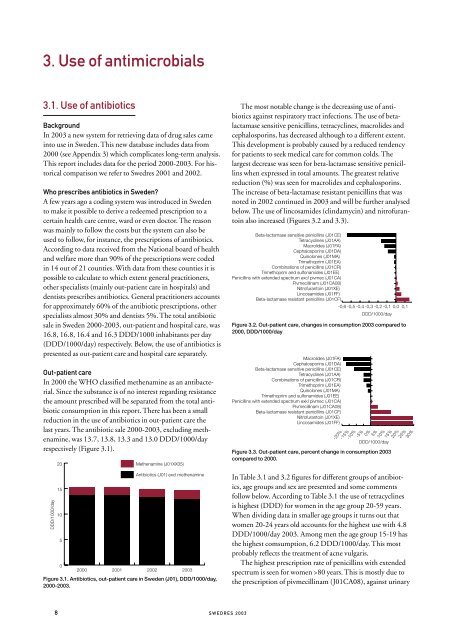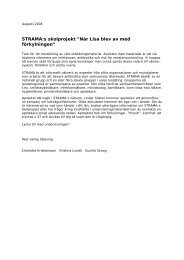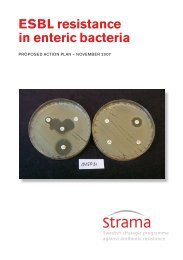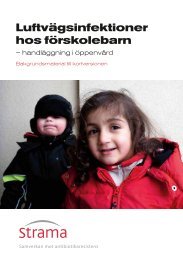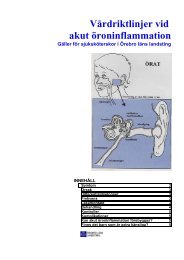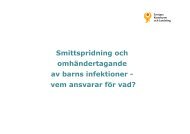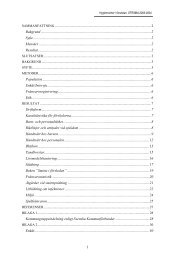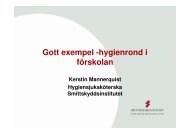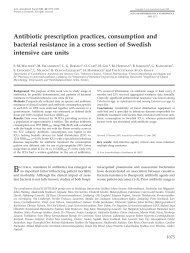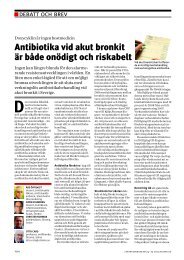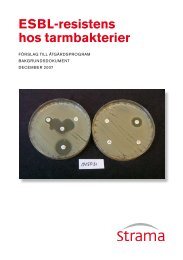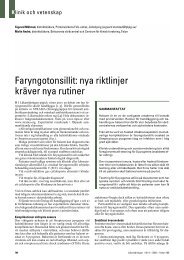Link - Snowfall
Link - Snowfall
Link - Snowfall
You also want an ePaper? Increase the reach of your titles
YUMPU automatically turns print PDFs into web optimized ePapers that Google loves.
3. Use of antimicrobials3.1. Use of antibioticsBackgroundIn 2003 a new system for retrieving data of drug sales cameinto use in Sweden. This new database includes data from2000 (see Appendix 3) which complicates long-term analysis.This report includes data for the period 2000-2003. For historicalcomparison we refer to Swedres 2001 and 2002.Who prescribes antibiotics in Sweden?A few years ago a coding system was introduced in Swedento make it possible to derive a redeemed prescription to acertain health care centre, ward or even doctor. The reasonwas mainly to follow the costs but the system can also beused to follow, for instance, the prescriptions of antibiotics.According to data received from the National board of healthand welfare more than 90% of the prescriptions were codedin 14 out of 21 counties. With data from these counties it ispossible to calculate to which extent general practitioners,other specialists (mainly out-patient care in hospitals) anddentists prescribes antibiotics. General practitioners accountsfor approximately 60% of the antibiotic prescriptions, otherspecialists almost 30% and dentists 5%. The total antibioticsale in Sweden 2000-2003, out-patient and hospital care, was16.8, 16.8, 16.4 and 16.3 DDD/1000 inhabitants per day(DDD/1000/day) respectively. Below, the use of antibiotics ispresented as out-patient care and hospital care separately.Out-patient careIn 2000 the WHO classified methenamine as an antibacterial.Since the substance is of no interest regarding resistancethe amount prescribed will be separated from the total antibioticconsumption in this report. There has been a smallreduction in the use of antibiotics in out-patient care thelast years. The antibiotic sale 2000-2003, excluding methenamine,was 13.7, 13.8, 13.3 and 13.0 DDD/1000/dayrespectively (Figure 3.1).DDD/1000/day20 Methenamine (J01XX05)15105020002001Antibiotics (J01) excl methenamine20022003Figure 3.1. Antibiotics, out-patient care in Sweden (J01), DDD/1000/day,2000-2003.The most notable change is the decreasing use of antibioticsagainst respiratory tract infections. The use of betalactamasesensitive penicillins, tetracyclines, macrolides andcephalosporins, has decreased although to a different extent.This development is probably caused by a reduced tendencyfor patients to seek medical care for common colds. Thelargest decrease was seen for beta-lactamase sensitive penicillinswhen expressed in total amounts. The greatest relativereduction (%) was seen for macrolides and cephalosporins.The increase of beta-lactamase resistant penicillins that wasnoted in 2002 continued in 2003 and will be further analysedbelow. The use of lincosamides (clindamycin) and nitrofurantoinalso increased (Figures 3.2 and 3.3).Beta-lactamase sensitive penicillins (J01CE)Tetracyclines (J01AA)Macrolides (J01FA)Cephalosporins (J01DA)Quinolones (J01MA)Trimethoprim (J01EA)Combinations of penicillins (J01CR)Trimethoprim and sulfonamides (J01EE)Penicillins with extended spectrum excl pivmec (J01CA)Pivmecillinam (J01CA08)Nitrofurantoin (J01XE)Lincosamides (J01FF)Beta-lactamase resistant penicillins (J01CF)Figure 3.2. Out-patient care, changes in consumption 2003 compared to2000, DDD/1000/dayMacrolides (J01FA)Cephalosporins (J01DA)Beta-lactamase sensitive penicillins (J01CE)Tetracyclines (J01AA)Combinations of penicillins (J01CR)Trimethoprim (J01EA)Quinolones (J01MA)Trimethoprim and sulfonamides (J01EE)Penicillins with extended spectrum exkl pivmec (J01CA)Pivmecillinam (J01CA08)Beta-lactamase resistant penicillins (J01CF)Nitrofurantoin (J01XE)Lincosamides (J01FF)-20%-15%-10%-0,6 -0,5 -0,4 -0,3 -0,2 -0,1 0,0 0,1DDD/1000/dayFigure 3.3. Out-patient care, percent change in consumption 2003compared to 2000.In Table 3.1 and 3.2 figures for different groups of antibiotics,age groups and sex are presented and some commentsfollow below. According to Table 3.1 the use of tetracyclinesis highest (DDD) for women in the age group 20-59 years.When dividing data in smaller age groups it turns out thatwomen 20-24 years old accounts for the highest use with 4.8DDD/1000/day 2003. Among men the age group 15-19 hasthe highest comsumption, 6.2 DDD/1000/day. This mostprobably reflects the treatment of acne vulgaris.The highest prescription rate of penicillins with extendedspectrum is seen for women >80 years. This is mostly due tothe prescription of pivmecillinam (J01CA08), against urinary-5%0%5%10%15%DDD/1000/day20%25%30%8 S W E D R E S 2 0 0 3


